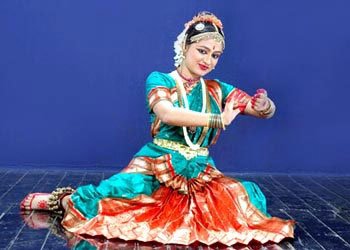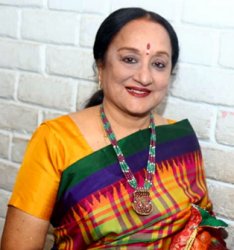
|   |

|   |
Sitting posture March 5, 2014  Sitting on the floor and doing abhinaya ....I don't mean veterans sitting and demonstrating.....I mean sprightly Bharatanatyam dancers sitting on the stage and showing some part of the narrative, has become common. Frankly I don't know where this has come from. Rather, I should say I know.....! Let us begin at the beginning. I would like to share experiences of my early training with Nattuvanars. There were a few distinct adavus which were supposed to connect your knees to the floor. This was an extension of the "muzhu" or full mandi as seen in the second half of the alarippu. Then we see "sarukkal" adavus in the composition of the jathiswaram where the knee touches the floor. There are, according to the old tradition, a variety of such muzhu mandi adavus and sarukkal adavus which are used in the korvais of the varnam too. In thillanas some elegant seated postures appear as part of the nrtta. Therefore in the adavu system, there is a small selection of floor movements which demands the dancer to use her knees to touch the floor. I have not seen any adavu where you actually sit with your derrière on the floor. Except the one Kalakshetra uses rather momentarily like a springboard to arise. That looks so elegant when done well. Now let us observe the idea of sitting on the floor and doing a narrative. Strictly speaking the development of a narrative is termed in Tamil as "Kai" ....or hand, denoting that one should use the gestures to tell the story. Of course suitable expressions accompanied it but not really very expansive. It was a detail of angika abhinaya , used in sabdams, varnams and padams. The hand and arm movements were always combined with appropriate HASTHA mudras as well as stances and foot movements. In my early experience whenever we sat to denote anything like ....making sandal paste, stringing flowers, drawing kolams, churning butter, etc. etc. we sat only in a mandi position with one knee on the floor. I cannot recollect any time sitting fully on the floor. That happened only when I learnt Kuchipudi. The dance was the Krishna Sabdam and I felt that the folk element in Kuchipudi was responsible for this kind of rather colloquial expression on the stage. There was also an air of seductive charm in this Sabdam so the whole sequence of offering betel leaves, as I have mentioned in my book, seemed to come straight out of the courtesan culture. The dancer sat in a pose on the floor and did a full sequence, using gestures and facial expressions. Very pretty and very Kuchipudi indeed. Nowadays, I find a lot of dancers sitting on the floor frequently during a performance. While giving distinct poses like Ananthasayanam which is easy, or some other sculpturesque pose of Shiva which is always a struggle on the stage, dancers especially the young ones with flexible limbs, look attractive. The other instances of heroines in distress sitting on the floor like Satyabhama in the Kuchipudi Bhamakalapam is effective only if the dancer can do it evocatively in a brief manner. Long minutes of this pining posture seem to me to defeat the purpose of the exercise. We tend to think.....okay, got it, when is the dancer going to get up? There is of course nowadays, a lot of drama in the narrative. Often big fights occur on the stage with staggering falls on the stage by the "evil" characters when vanquished by the good ones. Well, this is the aesthetic that the dancers know......hopefully she/ he will grow out of it someday.  Short spells on the floor can be attractive. Lighting helps in making these interludes sometimes quite nice. Provided the body is well aligned in a pleasing posture. We have uniformly bad stages when it comes to visibility by the audience. The levels of the stage in relation to the audience's seats are quite bad for dancing. Most of the time even when the dancer is standing we cannot see the feet. In this situation, long minutes of flat out sitting on the stage is not advisable. Dancers are seen doing lengthy minutes of puja or some such sequence on the floor. It is not a visual treat at all. Dancers nowadays also tend to over-do bhakti movements. I mean "shashtanga namskaram" on the stage as if you are in a temple near the dwajasthambam. Nattuvanars never taught us this! Melting on the floor with bhakti, may not have the great impact on the audience that you imagine. It can be cloying at times. In the olden days, the snake dance had many floor exercises. The movements were challenging and the audience found it worthwhile to crane their necks to see the slithering movements. There was a context to that movement. The challenge of a gymnastic movement in a time when nobody knew much about Bharatanatyam was accepted by the audience. In their enthusiasm to copy other styles, dancers indulge in sitting on the floor for no particular contextual reason. Sure, Guru Kelucharan Mohapatra did a languid "Kuru Yadu Nandana" seated on the floor and succeeded in holding everybody's attention. The lyrics suited that sequence and those who watched from good front row seats loved his delicate postures and detailed movements. Young dancers are agile enough to do anything. But I find it curious that they are eager to include many moves not native to Bharatanatyam. The one instance of circling the stage on the knees which is from the Manipuri dance style I think, only affirms the dancer's athletic prowess. Shiva Tandava can be shown in many other ways. Mature dancers, as I have pointed before, evolve movement inspired by sculpture, and link those poses with adavus. Movements which are alien to Bharatanatyam are better left to other styles. The identity of the style gets diluted. Imagine Kathak dancers doing araimandi! Or Mohiniattam dancers doing Nataraja poses. Or Odissi dancers doing thattu mettu and Kuchipudi dancers doing Kathak chakkars. Why, oh why, do Bharatanatyam dancers make compromises in the name of innovation? Now that there are no strict Gurus who control all content, dancers feel free to do anything. Their teachers are not strict enough or perhaps they are also involved in borrowing ideas. Young dancers obviously see role models in older dancers. If someone who is famous makes an ariddhi look like a Kathak sequence, everybody wants to blindly copy.....no, copy with eyes wide open. But is there a need to do this? The identity of a style is what makes our dances unique. It is possible to expand a repertoire without losing the very parameters of the style. Content will make the audience watch you. Work on each new piece for months before you put it on stage. Gimmicks are worth avoiding. Come on dancers, show some serious intent towards the art!  Lakshmi Vishwanathan, a prime disciple of Guru Kanjeevaram Elappa Pillai, is an exponent of the Thanjavur style of Bharatanatyam. She is also a trained vocalist. She is the author of several acclaimed books: Bharatanatyam - the Tamil Heritage, Kunjamma - Ode to a Nightingale, Kapaleeswara Temple, Women of Pride -The Devadasi Heritage. Her film 'The Poetry of Dance' was commissioned by the Festival of India. The Mamallapuram Dance Festival started in 1991 was Lakshmi's brainchild. She has served on several arts committees. She has served as Vice President of Music Academy (Chennai) and is a member of South Zone Cultural Centre. Comments Very well said, akka. I wish everyone reads this. As a teacher myself for the past 26 years, I think it is my duty and responsibility to pass on to the next generation the art in its pristine pure way...without adulteration. - Roja Kannan (March 6, 2014) Post your comments Pl provide your name and email id along with your comment. All appropriate comments posted with name and email id in the blog will also be featured in the site. |